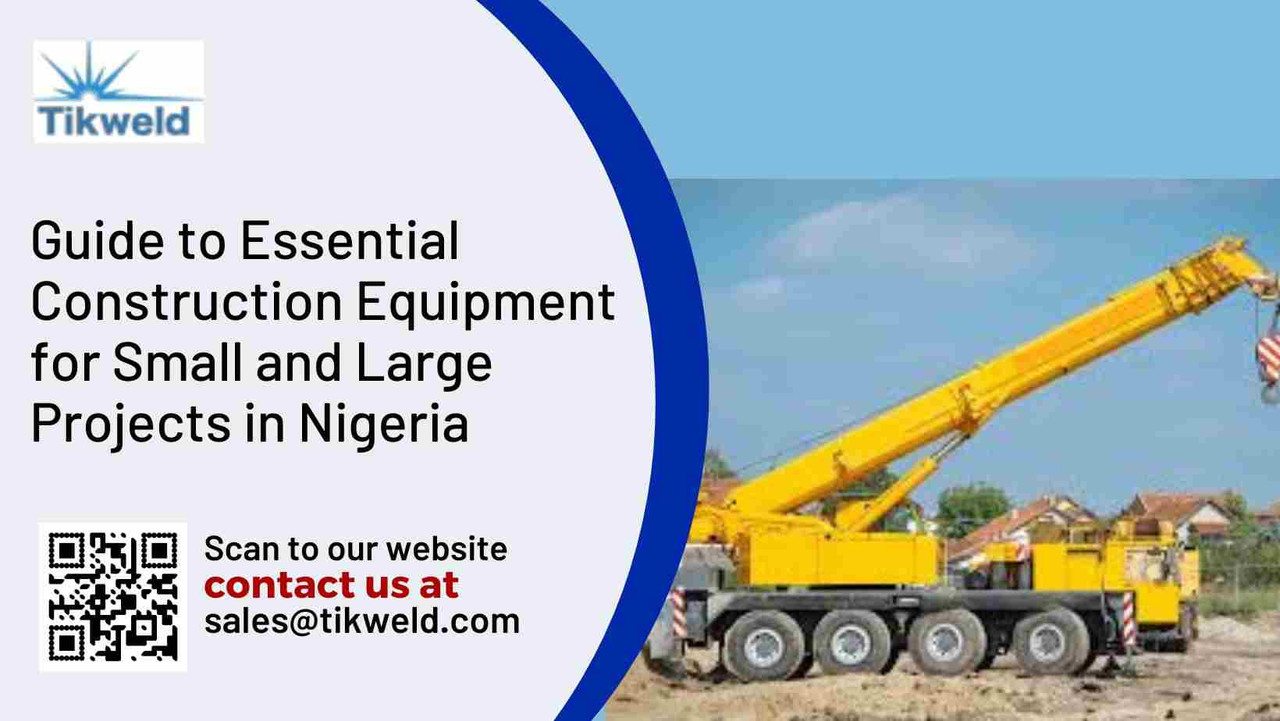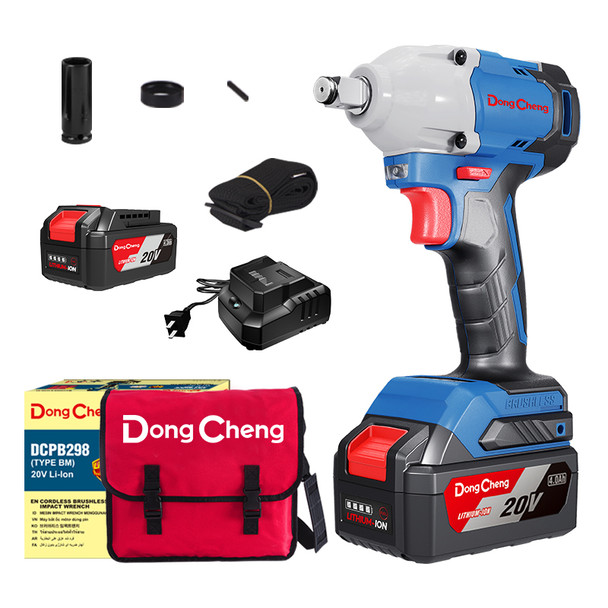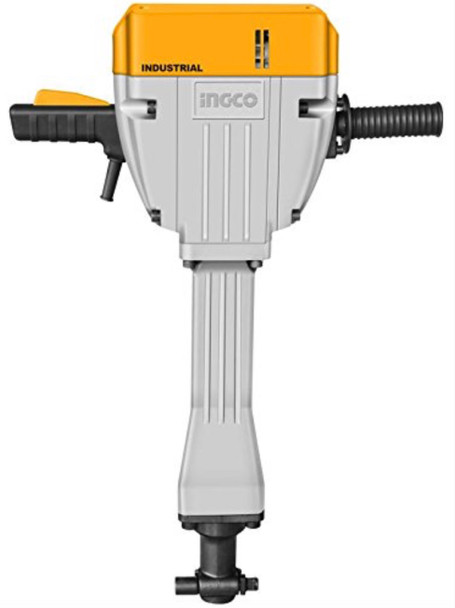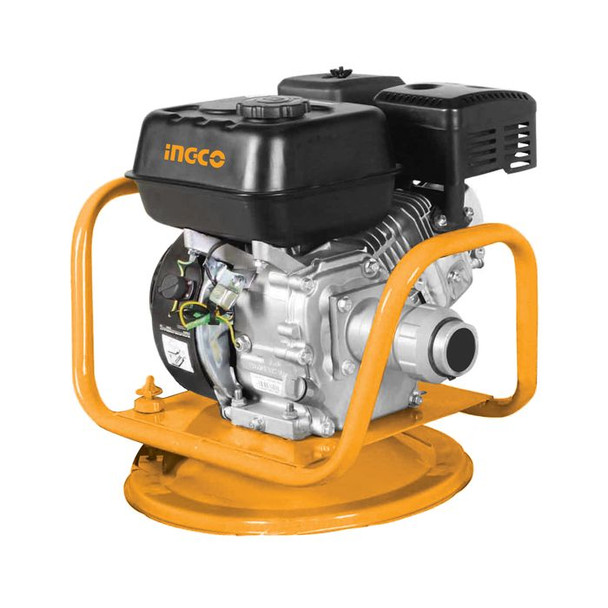Guide to Essential Construction Equipment for Small and Large Projects in Nigeria
Key Takeaways
Introduction
Selecting the right construction equipment is crucial for the successful execution of any project. The equipment you choose can significantly impact the efficiency, safety, and overall cost of the project. In Nigeria's dynamic construction industry, having the right equipment is crucial for completing projects efficiently and safely, whether you're working on a small-scale home renovation or a large commercial development.
From compact machinery ideal for smaller projects to heavy-duty machinery necessary for large-scale operations, understanding the benefits of each type of equipment is vital. The guide also offers practical tips on equipment maintenance, ensuring longevity and reliability. Whether you're a contractor or a project manager, this resource will help you make informed decisions, optimize project efficiency, and ensure successful outcomes.
DongCheng Cordless Brushless Impact Wrench
Understanding Project Types and Equipment Needs
Small-Scale Projects
Small-scale projects, such as home renovations, minor building projects, or simple repairs, typically require less complex machinery and tools. These projects focus on tasks like remodelling a kitchen, adding a room, or landscaping a yard. The equipment needed for these projects is generally compact, easy to use, and designed for versatility. Basic hand tools, power tools, and compact machinery are often sufficient to complete these tasks efficiently.
Large-Scale Projects
Large-scale projects, including the construction of commercial buildings, infrastructure development, or industrial facilities, demand heavy-duty machinery and specialised equipment. These projects involve extensive earth-moving, material handling, and high-precision tasks that require advanced technology. Equipment like excavators, bulldozers, cranes, and concrete pumps are essential for handling the scale and complexity of such projects. The selection of equipment for large-scale construction must consider the project's scope, the materials used, and the site conditions.
Essential Equipment for Small-Scale Projects
Hand Tools and Power Tools
For small-scale construction projects, hand tools and power tools are crucial. Hand tools like hammers, screwdrivers, and wrenches are the backbone of any construction toolkit, used for a variety of basic tasks. Power tools, such as drills, saws, and impact drivers, provide the necessary power and precision for more demanding jobs like cutting wood, drilling holes, or assembling structures. These tools are relatively affordable and easy to maintain, making them ideal for small contractors or DIY enthusiasts.
Compact Machinery
Compact machinery plays a vital role in small-scale projects, offering the power of larger equipment but in a more manageable size. Mini excavators are useful for digging foundations or trenches in tight spaces, while compact loaders can efficiently move materials around the site. Concrete mixers are essential for mixing small batches of concrete on-site, ensuring consistency and quality in construction. These machines are designed to be easy to operate, maintain, and transport, making them suitable for smaller projects with limited space.
Transportation and Lifting Equipment
Even on small projects, efficient transportation and material handling are crucial. Wheelbarrows and hand trucks are simple yet effective tools for moving materials like sand, cement, and bricks. For slightly heavier lifting tasks, light-duty cranes or hoists can be used to lift and position materials without the need for large, expensive machinery. Properly managing transportation and lifting equipment helps to reduce manual labour, improve safety, and increase overall project efficiency.
Demolition Hammer and Breaker INGCO PDB22001
Essential Equipment for Large-Scale Projects
Heavy Machinery
Large-scale construction projects require heavy machinery to handle extensive tasks like earth-moving, material transportation, and structural assembly. Excavators are essential for digging foundations, trenches, and removing large amounts of soil. Bulldozers are used to clear and level land, preparing the site for construction. Graders are critical for creating smooth, flat surfaces, particularly for road construction. Cranes are indispensable on large projects, enabling the lifting and placement of heavy materials like steel beams and precast concrete. Loaders and backhoes are versatile machines used for moving materials, digging, and even demolition.
Specialised Equipment
For more complex tasks, specialised equipment is necessary. Pile drivers are used in projects requiring deep foundations, driving piles into the ground to support structures. Concrete pumps are essential for efficiently transporting and placing concrete, especially in high-rise buildings. Tower cranes are crucial for tall structures, allowing materials to be lifted to great heights safely. Asphalt pavers are used in road construction to lay asphalt evenly across the surface. Trenchers are specialised for digging trenches, especially for laying pipelines or cables. This specialised equipment ensures precision and efficiency in large-scale projects, reducing the time and labour required for completion.
Material Handling Equipment
Handling materials effectively is a key aspect of large-scale construction. Forklifts and telehandlers are essential for moving heavy materials around the site. These machines provide the strength and versatility needed to transport pallets, steel, and other bulky items. Conveyor belts are used in large projects to move materials over long distances efficiently, reducing the need for manual labour. Heavy-duty cranes and trucks are necessary for transporting materials and equipment to and from the construction site, ensuring that the project remains on schedule. Effective material handling is crucial for maintaining the flow of work and minimising delays.
Benefits of Using the Right Equipment
1. Efficiency and Productivity
Using the appropriate construction equipment significantly enhances the efficiency and productivity of a project. Heavy machinery like excavators and cranes can complete tasks in a fraction of the time it would take with manual labour, allowing projects to progress faster. Power tools and compact machinery also contribute to higher accuracy and quality, reducing the need for rework and minimising material waste. By selecting the right equipment, construction companies can complete projects on time and within budget.
2. Safety and Risk Reduction
Safety is a top priority in construction, and using the right equipment plays a critical role in reducing risks. Heavy machinery and specialised equipment are designed with safety features that help prevent accidents, such as anti-rollover systems, load sensors, and operator cabins that protect against falling debris. Properly maintained equipment reduces the likelihood of malfunctions that could lead to injuries. Additionally, using machinery that is suited to the task at hand minimises the need for dangerous manual labour, further enhancing site safety.
3. Cost-Effectiveness
While the initial investment in construction equipment can be significant, it often leads to long-term cost savings. The right equipment reduces labour costs by completing tasks faster and more efficiently. It also minimises material waste and the likelihood of costly errors or rework. In many cases, the efficiency gains from using the right machinery offset the purchase or rental costs, making it a cost-effective choice for construction companies. Furthermore, properly maintained equipment has a longer lifespan, reducing the need for frequent replacements and repairs.
INGCO Gasoline Plate Compactor GCP 060-2
Tips for Selecting Construction Equipment
1. Assessing Project Requirements
Before selecting construction equipment, it’s essential to thoroughly assess the project’s specific needs. Consider the scale, complexity, and duration of the project. For smaller projects, compact and multi-functional tools may suffice, while large-scale operations require more robust, specialised machinery. Understanding the project's requirements helps in choosing equipment that aligns with the scope and goals of the construction.
2. Considering Equipment Versatility
Versatility is a crucial factor when selecting construction equipment, especially for projects with varying tasks. Multi-functional machines, such as backhoe loaders, which combine digging and loading capabilities, can be more cost-effective and efficient. Choosing versatile equipment reduces the need for multiple machines, saving both time and money while ensuring flexibility on the job site.
3. Evaluating Budget Constraints
Budget is a critical consideration in equipment selection. Contractors must weigh the costs of purchasing versus renting equipment. Renting may be more economical for short-term or one-time projects, while purchasing is beneficial for long-term or repetitive tasks. Budget constraints should also account for operational costs, maintenance, and potential resale value of the equipment.
4. Equipment Availability and Support
Availability of spare parts, maintenance services, and technical support is vital when selecting construction equipment. Opt for brands and suppliers with a strong presence in Nigeria, ensuring that parts and services are readily available. This minimises downtime and ensures that the equipment remains operational throughout the project, avoiding delays and additional costs.
Maintenance and Care for Construction Equipment
1. Routine Inspections and Preventative Maintenance
Regular inspections and preventative maintenance are essential for keeping construction equipment in optimal condition. Routine checks help identify potential issues before they become major problems, reducing the risk of breakdowns and costly repairs. Maintenance tasks, such as oil changes, filter replacements, and tire checks, should be performed according to the manufacturer’s recommendations.
2. Proper Storage and Handling
Proper storage and handling of construction equipment are crucial for extending its lifespan. Equipment should be stored in a dry, secure location to prevent damage from weather conditions and unauthorised access. Moving and operating machinery according to the manufacturer’s guidelines also helps prevent wear and tear, ensuring the equipment remains in good working order.
3. Operator Training and Safety Protocols
Training operators on the correct use of equipment is essential for both safety and efficiency. Proper training reduces the risk of accidents and ensures that machinery is used correctly, preventing unnecessary damage. Implementing safety protocols, such as wearing protective gear and following operational guidelines, further enhances safety on the job site.
4. Keeping Maintenance Records
Maintaining detailed records of all inspections, repairs, and maintenance activities is important for tracking the health of the equipment. These records help in planning maintenance schedules, budgeting for repairs, and making informed decisions about equipment replacement. Well-documented maintenance history also increases the resale value of the machinery.
Gasoline Concrete vibrator (Clawtype) INGCO GVR-2
Frequently Asked Questions
1. What is the best approach to choosing between renting and buying construction equipment?
Consider the project's duration, budget, and frequency of use. Renting is often better for short-term needs, while buying is more cost-effective for long-term or repeated use.
2. How often should construction equipment be inspected?
Equipment should be inspected before each use and undergo more thorough checks as per the manufacturer's maintenance schedule.
3. What are the most common maintenance issues with heavy machinery?
Common issues include engine malfunctions, hydraulic system leaks, and wear on moving parts. Regular maintenance helps prevent these problems.
4. How can I ensure the safety of operators using construction equipment?
Provide proper training, enforce the use of safety gear, and ensure that all equipment is regularly maintained and operated according to safety protocols.
5. What should I look for in a reliable construction equipment supplier in Nigeria?
Look for suppliers with a strong local presence, good customer service, availability of spare parts, and a reputation for quality products
Related Articles
The Essential Guide to Industrial Supplies in Nigeria
Essential Safety Equipment for Construction Workers in Nigeria
Conclusion
Selecting the right construction equipment is critical for the success of any project, whether small or large. By understanding the specific needs of your project, choosing versatile and reliable machinery, and maintaining it properly, you can ensure efficient, safe, and cost-effective operations. Investing in the right tools not only enhances productivity but also safeguards the safety of workers and the longevity of the equipment.
For high-quality construction equipment tailored to your project needs, visit Tikweld Welding Supplies. Explore a wide range of reliable machinery and tools, backed by excellent customer support and maintenance services. Whether you're handling a small renovation or a large-scale construction project, Tikweld has the equipment you need to succeed.












